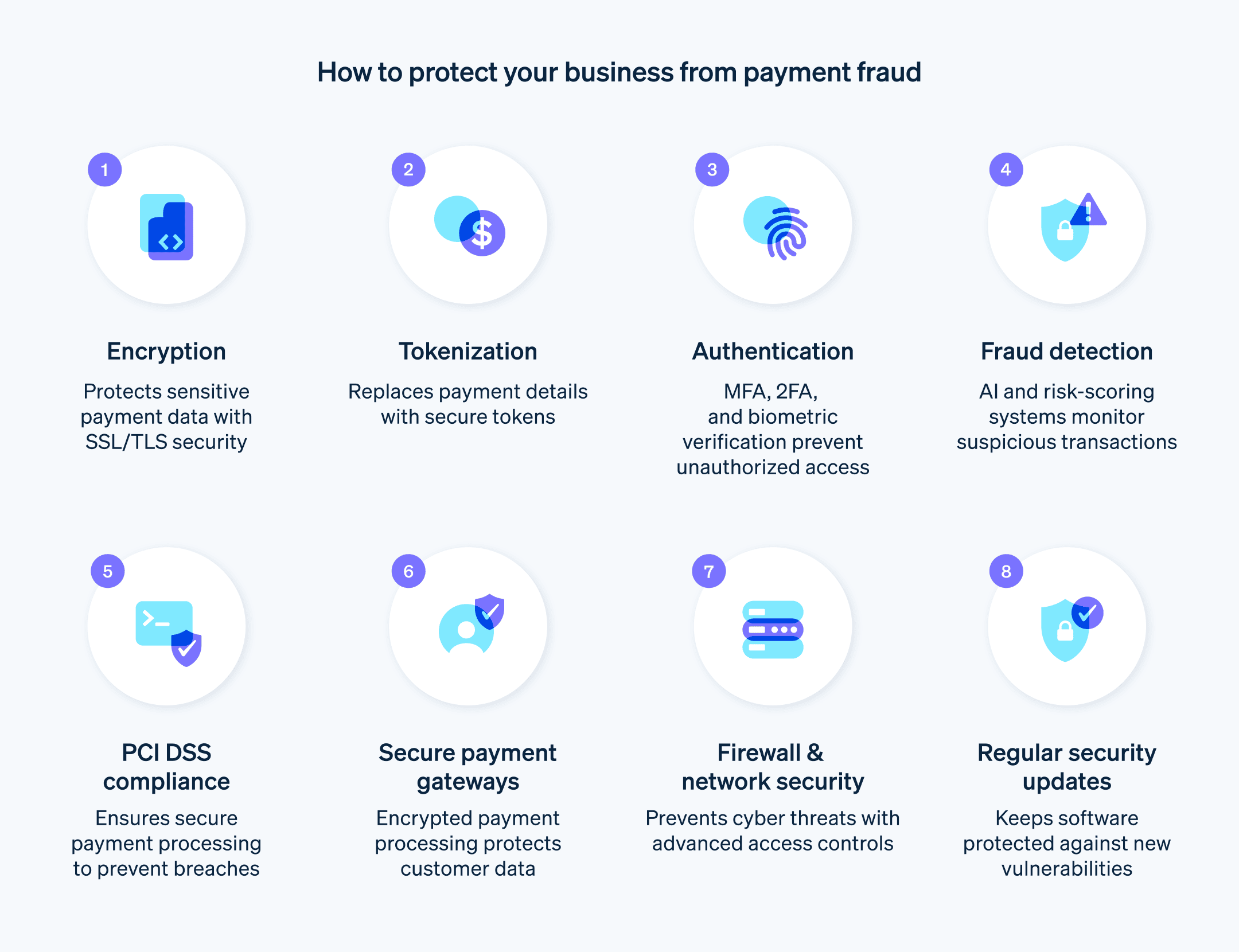所有商家都应重视支付安全。2024 年,有 79% 的企业机构声称曾遭遇支付欺诈。支付欺诈可能造成巨额损失,全球数据泄露事件的平均成本高达 440 万美元。企业必须将支付安全置于优先地位,这既是保护客户敏感信息、维护用户信任的必要举措,也是避免重大财务损失的关键防线。
本指南包含一系列可操作的步骤,助您制定并实施稳健的支付安全策略。无论您是电商零售商、实体店铺还是 SaaS 提供商,企业的成功都离不开完善的支付安全策略作为支撑。
本文内容
- 什么是支付安全?
- 支付安全原则
- 支付服务商应具备的安全特性
- 商家的最佳安全实践
- Stripe Radar 如何提供帮助
什么是支付安全?
支付安全是指保护金融交易免受未授权访问、数据泄露和欺诈的一系列系统、流程及措施。无论是线上还是线下业务,确保支付安全都至关重要,它不仅能维持客户信心、减少财务损失,更是遵守相关法规与行业标准的基本要求。
支付安全原则
支付安全遵循多项协同运作的原则,共同保障金融交易与客户数据的安全。其中需要了解的核心原则包括:
加密
加密技术能保护敏感的客户数据与金融交易,防止其遭受未授权访问、篡改及窃取。加密主要有两种类型:对称加密与非对称加密。对称加密使用同一把密钥进行数据的加密与解密;而非对称加密(亦称“公钥加密”)则使用一对密钥:公钥用于加密,私钥用于解密。通常而言,非对称加密被认为安全性更高,因为私钥无需对外共享。
商家使用安全套接层 (SSL) 和传输层安全 (TLS) 等加密协议,确保客户浏览器与商家网站或支付平台之间的数据传输安全。SSL/TLS 加密采用对称和非对称加密相结合的方式,建立安全连接,保障数据在传输过程中的安全。
令牌化
令牌化技术通过将敏感支付信息替换为无实际意义的唯一令牌来提供保护,这些令牌即使被窃取也毫无价值。该技术能显著降低未授权访问和数据泄露的风险,同时确保符合行业标准与法规要求。
支付令牌化将敏感数据(如信用卡号)替换为由安全系统生成的唯一令牌。这些令牌用于引用原始支付信息,原始支付信息存储在一个集中的令牌库中。令牌本身不能用于进行欺诈交易,也无法反向推导出原始支付数据。
身份验证
身份验证是验证用户身份的基本支付安全措施,确保只有授权用户才能访问或完成交易。
身份验证有几种类型,包括:
- 单因素身份验证 (SFA): 需要一种识别方式,通常是密码或 PIN 码
- 双重验证 (2FA): 需要两种识别方式,例如密码和发送到注册设备的一次性验证码
- 多因素身份验证 (MFA): 需要三种或更多的识别方式,可能包括生物特征数据、安全问题或物理令牌
欺诈检测和预防
这些系统通过监控交易模式、客户行为及其他风险因素,帮助企业识别并防范欺诈交易。机器学习算法、行为分析与风险评分等技术能够有效侦测异常行为并阻止欺诈。欲了解更多详情,请参阅我们的反欺诈检测指南。
支付卡行业数据安全标准合规
支付卡行业数据安全标准 (PCI DSS) 是一套安全规范,旨在确保所有处理、存储或传输信用卡信息的商业机构都能维持安全的环境。遵循 PCI DSS 标准能够有效保护客户敏感数据,并最大限度地降低数据泄露风险。
实现并持续维护 PCI DSS 合规性至关重要,这既能保护客户的敏感支付信息,也彰显了企业对安全承诺的践行。
支付网关
支付网关在保障客户支付数据免受未授权访问和欺诈的同时,为卡交易处理提供支持。它通过在客户、商户、支付处理商及收单行之间建立安全的信息传输通道,成为构建高安全性支付环境的重要组成部分。
防火墙和网络安全
防火墙和网络安全有助于保护支付基础设施和客户的机密数据免受外部威胁,如黑客、恶意软件和其他恶意行为者的攻击。
防火墙是一种安全系统,类似于计算机网络的保安,依据特定规则控制进出信息。防火墙在企业内部受信任的网络(如支付系统)和外部不受信任的世界(如互联网)之间创建保护屏障,帮助防止未经授权访问网络。防火墙可以是硬件、软件或两者的组合。
防火墙和网络安全的一些关键方面包括:
网络分段
将网络划分为较小、隔离的段,有助于限制安全漏洞造成的潜在损害。通过将敏感支付数据和系统放置在不同的网络段中,企业可以更好地保护这些资产免受未经授权的访问,并减少 PCI DSS 合规的工作负担。入侵检测与防御系统 (IDPS)
IDPS 解决方案通过监控网络流量来发现可疑活动,检测潜在威胁,并采取措施防止或缓解这些威胁。通过使用多种方法,如检查已知威胁和分析通信规则,IDPS 解决方案能够识别并阻止许多类型的攻击,即使是全新的攻击方式。强访问控制
如多因素身份验证 (MFA)、基于角色的访问控制 (RBAC) 以及“最小权限原则”(即为个人或实体授予执行与支付处理相关的具体任务所需的最少访问权限)等访问控制措施,有助于确保只有授权用户能够访问网络资源和敏感支付系统。安全监控和事件响应
持续监控网络活动,并结合完善的事件响应计划,帮助企业快速识别并应对安全威胁,最大限度地减少潜在损害和宕机时间。
安全更新和补丁
软件供应商、硬件制造商和操作系统提供商会发布安全更新和补丁,以解决其产品中已知的漏洞、错误或其他安全问题。定期的安全更新和补丁有助于保护支付基础设施、客户数据和其他关键系统免受漏洞、网络攻击和未经授权的访问。
定期应用这些更新和补丁有助于:
修复漏洞
更新和补丁解决了黑客可能利用的安全漏洞或弱点,这些漏洞可能使黑客获得对系统的未经授权访问或窃取敏感数据。通过及时安装安全补丁,您可以减少数据泄露和网络攻击的风险。改善性能
更新通常包括性能改进、错误修复或新增功能,可以提高系统和软件的整体稳定性、效率和功能性。保持合规性
法规要求通常明确规定企业必须及时安装安全更新与补丁以维持合规状态。定期更新系统有助于避免因不合规而面临的罚款或处罚。防范新兴威胁
随着黑客发现新的漏洞并开发新的攻击技术,网络威胁不断演变。应用更新和补丁帮助您在这些新兴威胁面前保持领先,并维护安全环境。

支付服务商应具备的安全特性
选择支付服务商时,需要考量的因素很多——从安全功能、合规性,到系统正常运行时间与可靠性等诸多方面。
选择支付服务商时,需要关注的关键特性包括:
加密
安全的支付服务商应采用加密协议对敏感支付数据进行加密。这些协议能确保客户的支付信息在传输过程中保持安全,防止数据被拦截或篡改。令牌化
应对卡号等支付数据做令牌化处理,以保护客户信息、降低数据泄露风险,并确保符合 PCI DSS 标准。身份验证与欺诈预防
集成多种身份验证方法,例如 CVV/CVC 校验、3D 安全认证及生物识别技术,以核实客户身份并防止未授权交易。此外,还需确保服务商配备先进的欺诈检测与预防系统,这些系统应能运用机器学习、行为分析和风险评分等技术,实时识别并拦截欺诈交易。符合行业标准
支付服务商应遵循 PCI DSS 及其他相关行业标准,以确保为持卡人数据的处理、存储和传输维持一个安全的环境。正常运行时间和可靠性
维持高水平的正常运行时间和可靠性,可确保客户能够顺利完成交易,避免中断。通过常态化监控、冗余措施和稳健的基础架构,支付服务商能够持续安全且高效地处理交易。
商家的最佳安全实践
所有处理、存储或传输支付信息(包括信用卡数据)的企业,都需关注支付安全问题。无论企业规模大小、所属行业如何,维护安全的支付流程都至关重要——这不仅能保护客户的敏感数据、赢得客户信任,还能确保商家符合行业标准与相关法规要求。
为确保在支付安全管理方面有一套周到的方法,商家应采取以下步骤:
1. 进行风险评估
首先查看您当前的支付基础设施、流程和系统,识别潜在的漏洞和改进空间。确定企业处理的敏感数据类型,以及这些数据的存储、处理和传输位置。
2. 了解合规要求
熟悉包括 PCI DSS 在内的行业监管合规标准和规范,并基于所在市场确定商家的具体合规要求。确保了解这些标准所强制要求的安全控制和实践。对员工进行 PCI DSS 要求和安全处理持卡人数据最佳实践方面的培训。
3. 制定安全政策和程序
制定明确的支付安全政策和程序,包括处理敏感数据、访问控制、事故响应、补丁管理和员工培训的指导方针。确保这些政策和程序符合行业标准和法规。
4. 采取安全措施
基于风险评估和合规要求,实施适当的安全措施,如加密、令牌化、强身份验证和防火墙配置。选择安全支付服务商,并与符合 PCI DSS 标准的供应商合作,以简化合规工作。
5. 监控系统并进行压力测试
定期监控支付系统、网络和应用,排查潜在威胁或漏洞。漏洞扫描、渗透测试和系统审计等策略可用于评估安全措施的有效性,并找出需要改进的方面。此外,还可考虑使用自动化工具,这类工具有助于识别未安装的补丁程序或过时的软件。
6. 按指示调整方法
即便是最周密的安全策略,也需要随时间推移进行调整和完善。请持续评估支付安全策略的有效性,并根据业务发展、行业法规或威胁态势的变化及时优化。定期审查有助于确保您的策略始终切实有效地保护客户数据。
7. 制定事件响应计划
制定明确的事件响应计划,以指导组织在发生安全漏洞或其他事件时的应对措施。该计划应概述角色和责任、沟通协议以及遏制和缓解事件的程序。
Stripe Radar 如何提供帮助
Stripe Radar 利用来自全球 Stripe 网络的数据训练 AI 模型,以侦测和防范欺诈。该服务会基于最新的欺诈趋势持续更新这些模型,从而在欺诈手段不断演变时保护您的业务。
Stripe 还提供 Radar 风控团队版,该版本允许用户添加特定于其业务的自定义欺诈场景识别规则,并支持获得高级欺诈洞察。
Radar 可以帮助您的企业:
- 预防欺诈损失: Stripe 每年处理超过 1 万亿美元的支付。这种独特的规模使 Radar 能够准确检测和预防欺诈,为您节省资金。
- 提高收入: Radar 的人工智能模型接受了实际争议数据、客户信息、浏览数据等的训练。这使 Radar 能够识别高风险交易并减少误报,从而增加您的收入。
- 节省时间: Radar 内置在 Stripe 中,无需编写任何代码即可设置。您还可以在一个平台上监控欺诈表现、编写规则等,提高效率。
本文中的内容仅供一般信息和教育目的,不应被解释为法律或税务建议。Stripe 不保证或担保文章中信息的准确性、完整性、充分性或时效性。您应该寻求在您的司法管辖区获得执业许可的合格律师或会计师的建议,以就您的特定情况提供建议。